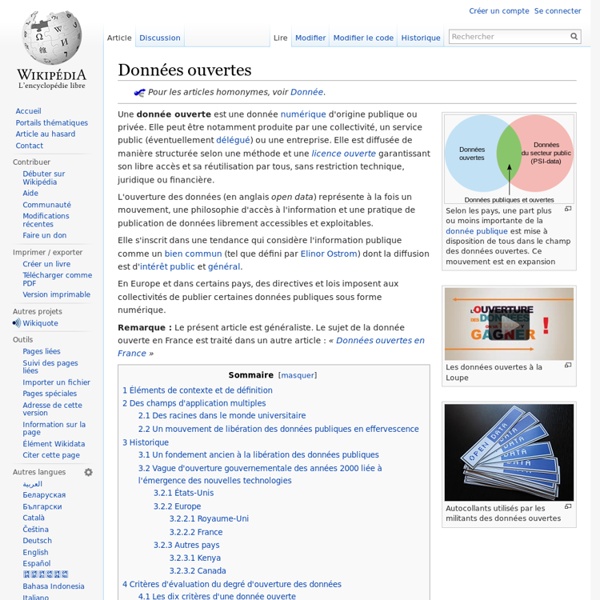



http://fr.wikipedia.org/wiki/Donn%C3%A9es_ouvertes
Related: mimipmrThe Future of Existential Psychology: Humanistic Psychology’s Chief Task: To Reset Psychology on its Rightful Existential Base Posted on 14 Feb | 3 comments Photo by NASA. While some in the field continue to believe that psychology proceeds purely on the basis of positivistic science (e.g., Baker, McFall, & Shoham, 2008), I contend that this is patently naïve. Psychology was and probably always will be a philosophically based discipline. In this light, the field of psychology has actually been “reset” many times over its relatively brief 100-year history, and this resetting has had as much to do with philosophical fashion as it has had to do with empirical evidence (see Kuhn, 1962). The first time the field was reset was at the point where its standing as an explicit philosophy was replaced by its “formalization” as an explicit laboratory science.
Out-of-home advertising Out-of-home advertising licence (OOHOLIC) (or outdoor advertising license) is made up of more than 100 different formats, totaling $6.7 billion in annual revenues in 2012 in the USA.[1] Outdoor advertising is essentially any type of advertising that reaches the consumer while he or she is outside the home. This medium is in contrast with broadcast, print, and Internet advertising. Out of home advertising, therefore, is focused on marketing to consumers when they are "on the go" in public places, in transit, waiting (such as in a medical office), and/or in specific commercial locations (such as in a retail venue). Outdoor advertising formats fall into four main categories: billboards, street furniture, transit, and alternative.[2]
Captology Captology is the study of computers as persuasive technologies. This includes the design, research, and analysis of interactive computing products (computers, mobile phones, websites, wireless technologies, mobile applications, video games, etc.) created for the purpose of changing people’s attitudes or behaviors. BJ Fogg derived the term captology in 1996 from an acronym: Computers As Persuasive Technologies = CAPT. Where Persuasion and Computers Intersect The field of captology and persuasive technology is growing quickly. Every day more computing products, including websites and mobile apps, are designed to change what people think and do.
Application programming interface Set of subroutine definitions, protocols, and tools for building software and applications More recently, the term has been often used to refer to a specific kind of interface between a client and a server, which has been described as a “contract” between both - such that if the client makes a request in a specific format, it will always get a response in a specific format or initiate a defined action.[1] This is a specialized form of API, sometimes defined as a WEB API. Purpose[edit] Usage[edit] Libraries and frameworks[edit]
8 Ways to Identify Unmet Customer Needs: Measuring Usability Jeff Sauro • September 23, 2014 Innovation can't be legislated. It can't be bought. Where does it come from? Innovation comes from identifying customers' needs and meeting them. Easy to understand. Category:Humanist sans-serif typefaces This category contains typefaces in the humanist sans-serif classification. They first appeared in the early twentieth century. Humanist sans-serif typefaces are characterized by the presence of the hand, an uppercase similar in proportion to the monumental Roman capitals, a lowercase similar in form to the Carolingian script, and an overall more organic structure. Humanist sans-serif typefaces frequently have a true italic rather than a sloped roman.
The B2B2C model Jessica Tayenjam is a consultant at Rapid Innovation Group, where she helps high potential, technology-enabled companies mitigate market risk and create scalable growth. She is one of the speakers at our Startup 101 course on Saturday 9th March (tickets still available – download the free preview book here). Here, she shares her thoughts on the B2B2C model.
Human interface guidelines Human interface guidelines (HIG) are software development documents which offer application developers a set of recommendations. Their aim is to improve the experience for the users by making application interfaces more intuitive, learnable, and consistent. Most guides limit themselves to defining a common look and feel for applications in a particular desktop environment. The guides enumerate specific policies. Policies are sometimes based on studies of human-computer interaction (so called usability studies), but most are based on arbitrary conventions chosen by the platform developers.
Artificial neural network An artificial neural network is an interconnected group of nodes, akin to the vast network of neurons in a brain. Here, each circular node represents an artificial neuron and an arrow represents a connection from the output of one neuron to the input of another. For example, a neural network for handwriting recognition is defined by a set of input neurons which may be activated by the pixels of an input image. Nanotechnology Now - Press Release: "Sussex physicists find simple solution for quantum technology challenge" Home > Press > Sussex physicists find simple solution for quantum technology challenge Abstract: A solution to one of the key challenges in the development of quantum technologies has been proposed by University of Sussex physicists. Brighton, UK | Posted on October 28th, 2014 In a paper published today (28 October) in Nature Communications, Professor Barry Garraway and colleagues show how to make a new type of flexibly designed microscopic trap for atoms.
The golden opportunity of paradigm shifts These 6 major paradigm shifts, disruptions in how we see the world and do business, present both danger, and opportunity to innovation leadership today. The leading paradigms of today are being challenged by new approaches based on different beliefs and assumptions. New paradigms lead to new business models and production techniques, new forms of collaboration and cooperation, new forms of financing and ownership, and new forms of learning. Recognizing these paradigm shifts helps innovation leadership in discovering opportunities in a wide variety of fields and to develop game-changing business models.